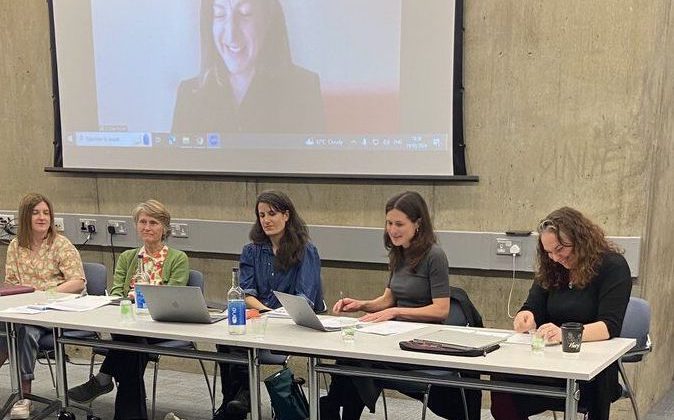How open is justice?
This was the question discussed last month, at a panel discussion held in the Institute of Advanced Legal Studies under the heading “Technology, Transparency and Criminal Justice”.… Continue reading

Technology, Transparency and Criminal Justice
Marking the launch of Observing Justice by Judith Townend and Lucy Welsh (Bristol University Press), this seminar examined the recent and long term legal, social and technological developments that have affected the transparency and accountability of the criminal justice process. Speakers from academic, civil society and legal organisations shared insights from their research and professional experiences on key legal policy issues such as equality of access, remote and virtual courts, justice system data management, and the roles of public and media observers.
The event at the Institute of Advanced Legal Studies on 19 March was chaired by Kate Leader (QMUL School of Law) with contributions from Lisa Flower (Lund University), Penelope Gibbs (of Transform Justice) and Amy Kirby (Birkbeck), as well as the authors Townend and Welsh whose book provided the background to the discussion.
A common theme that emerged from both the book and the discussion was the difference between the official line continually trumpeted by the courts and judges about the importance of open justice, and the reality of practice on the ground, where numerous obstacles and challenges are faced by court and tribunal observers — particularly if excluded from the charmed category of so-called “accredited media”. Public observers are often regarded more as a nuisance, whose scrutiny of the courts’ business is resented.
Although the book is mainly aimed at coverage of criminal courts, particularly magistrates’ courts, much of its discussion applies equally to other courts. Open justice is assumed to guarantee a level of accountability because courts are subject to the scrutiny of the general public, either by watching personally or through the media on their behalf. The media are often described as “eyes and ears” of the public, but this presupposes they attend more commonly than the public they represent, and this assumption is open to doubt. The decline in court reporting, though largely anecdotal , owes more to the changing economics of newspaper journalism than to any hindrance from the courts, which continue to give media reporters a privileged access that can operate negatively as a barrier to participation by other observers. Examples of the latter include challenges from court staff questioning students or researchers about the purpose of their attendance in court, prohibiting public observers from taking notes in court, or simply failing to provide timely access to links for (increasingly common) remote hearings.
An extreme example of the problem was recounted during the seminar, concerning a court observer being physically ejected from a magistrates’ court building after court staff refused to accept that he was entitled to sit in the public gallery. The usual response to any complaint about such an incident is that it is simply an individual mistake, a “training issue”, as though that absolves the system of blame. Despite all the fine words about open justice, despite all the recommendations by parliamentary committees and a big consultation by the Ministry of Justice, the issue is not seen as sufficiently critical to be given the resources to ensure proper training and proper public information.
The book also examines how technology has not always improved transparency: a good example being the Single Justice Procedure, under which guilty pleas to low level criminal offences are dealt with summarily, and no doubt speedily and efficiently, but largely out of sight, in a streamlined process that is inevitably far less accountable than hearings in open court. Although information is available to accredited media reporters, it is only available to others in response to a request following judicial adjudication. This is typical of the “gatekeeping” that non-media observers often encounter.
For more about this useful and timely book, see: Journal of Law and Society, Meet the book author – Observing Justice: Digital Transparency, Openness and Accountability in Criminal Courts
Open letter to LCJ
Among those present at the IALS event were a number of members of the Court and Tribunal Observers’ Network, which also campaigns for better open justice. Their recent Open Letter to the Lady Chief Justice pointed out a worrying series of errors in recently published guidance from HM Courts & Tribunal Service on public access to court hearings and information. This week Baroness Carr of Walton-on-the-Hill CJ responded with a letter acknowledging that the HMCTS advice wrongly suggested that laptops could not be used in court and noted that the service had taken steps to make the necessary correction. The letter was copied to the Lord Chancellor and Chair of the Justice Select Committee, to whom the open letter had also been addressed. We hope this will lead not only to correction of errors in the HMCTS advice but also to better official engagement with and consultation of non-media court observers and other interested parties. See: Open Letter on HMCTS guidance: LCJ responds
Finally, in the interests of full transparency, I should record that Judith Townend and I have worked together on a number of projects and publications, including the Court and Tribunal Observers’ Network, the Transparency Project, the Media and Communications List User Group (MACLUG) and various articles including one cited in the book.
Featured image: photo by Jessica Shurson (University of Sussex School of Law).